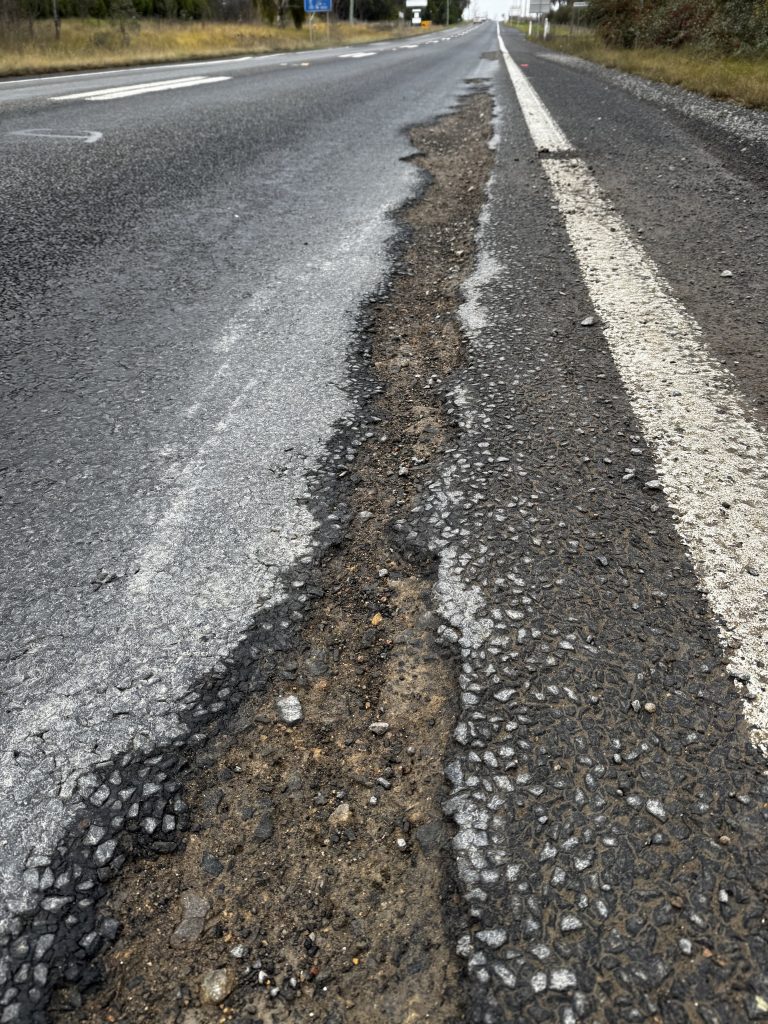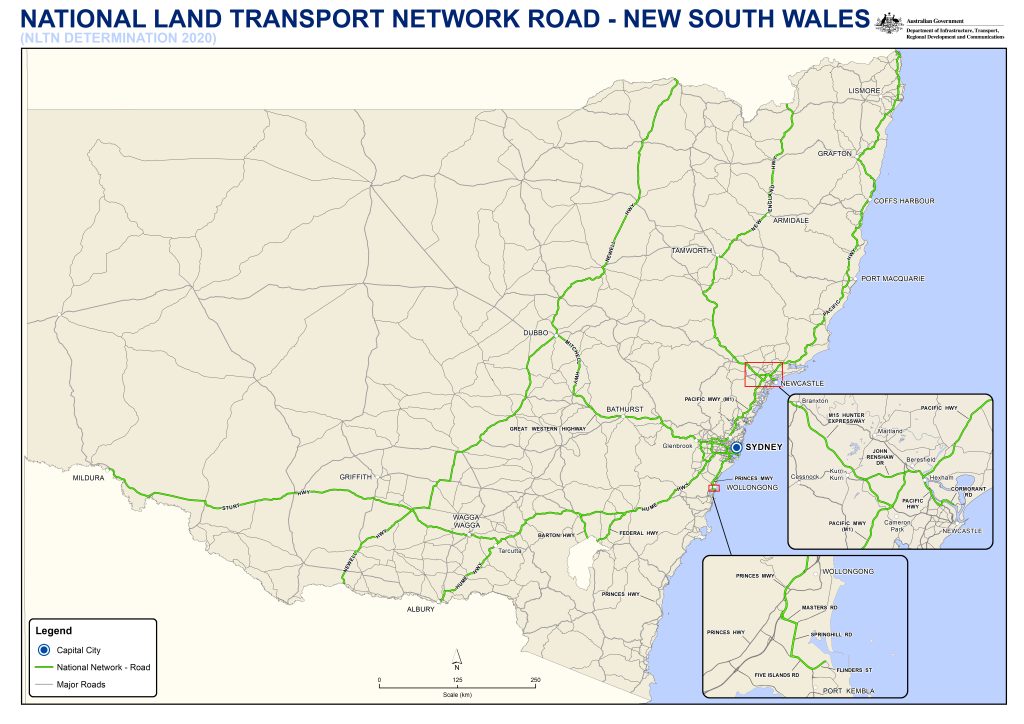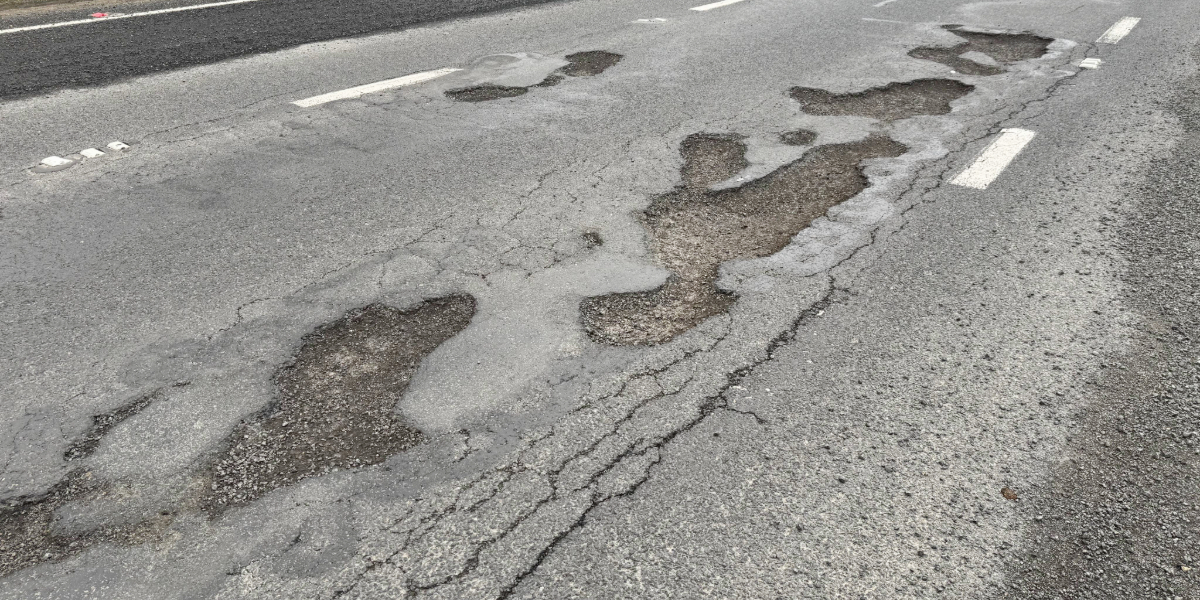The New England Highway has been prioritised for repairs on both sides of the border, with the federal government committed to funding disaster repairs, but the long term solution for the declared national highway that can’t handle national highway level traffic remains a challenge.
Motorists up and down the highway described the state of the road as dangerous, describing the efforts required to try and avoid the potentially axle-breaking potholes and long ridges in the road surface as ‘high speed slalem‘.
“I’m doing it now, straddling holes on the road. You’ve got two options, you can either blow a tyre out, or straddle to the left or right,” said Member for New England Barnaby Joyce, speaking to New England Times while travelling between engagements earlier this week.
“And as people are trying to avoid a pothole, they drive into a truck coming the other way.”
Joyce said he regularly brings the state of the New England Highway to the Government’s attention, saying it is a hard task to get appropriate funding because they are always looking to cut from different areas. The New England Highway had $30m in funding taken away in one of the first decisions of the Albanese Government in 2022.
“It’s a national highway, it’s got to be treated as a national priority,” he said.
“Even more so as the roads on the coast get inundated, this is where people gotta come.”
“We don’t put potholes on Live Traffic”: NSW Government dismisses the danger
Initial inquiries by New England Times and motorists to NSW Government’s Live Traffic service were largely dismissed, with no hazards other than flooding at Maitland and scheduled roadworks being reported for the New England Highway. When asked why dangerous sections of the road – with the specific example of a large area of damage near the weighbridge just outside of Willow Tree given – are not listed as a hazard on the Live Traffic site, a Transport Management Centre official snorted in derision and said “we don’t put potholes on Live Traffic”.
Multiple inquiries to the Minister for Roads Jenny Aitchison, Transport for NSW, and other NSW Government contacts were largely rebuffed as being exaggerated or not being as important as the flood response, with the dismissal of dangerous road conditions as ‘pot holes’ not being worthy for the Live Traffic website repeated in the first official comment from Transport for NSW.
“Live Traffic NSW lists hazards and incidents that impact customer journeys. This can include a combination of specific incidents, such as crash or a hazard like a large pothole that may cause damage, or a broader warning about a stretch of road that may have several hazards present,” a spokesperson for Transport for NSW said.
“Live Traffic NSW would not typically highlight every issue over a stretch of road, including potholes.”
The spokesperson also asserted that there were multiple signs warning of the damage to the road along the New England Highway corridor, in stark contrast to the claims of motorists that there were no warnings of the road damage.
The dismissals continued until a video emerged of the moonscape created by rain and heavy traffic on the New England Highway just north of Armidale at the intersection of Blanch Road.
This section of the New England Highway was being widened and improved in significant roadworks that have been ongoing since last year, and were scheduled to be finished in a matter of weeks, with further upgrades along a 9km section of road and the intersection with Puddledock Road planned through until March 2026. However, as the top layer of asphalt had not been applied, the unsealed road simply gave way to the conditions.
“The unplanned diversion of high numbers of heavy vehicles, including B-doubles, onto an unsealed construction project would have serious impacts on both the project and the road condition. Unsealed surfaces are highly vulnerable to deformation under heavy loads, particularly in wet conditions,” a Transport for NSW spokesperson said.
With the crews and materials onsite, this section of roadworks was quickly repaired, and crews have been out patching the worst areas, but very significant road damage and trenches persist on many parts of the highway a week later.

Transport for NSW says that crews already on site are being diverted to deal with the damage, and additional crews will also be tasked to repairs. Five crews will be working between Willow Tree and Guyra for the next fortnight.
“All available Transport maintenance resources are working on repairs. Planned construction activity has been reprogrammed to prioritise patching the New England Highway.”
“Assessments continue on the road network and maintenance crews will accelerate activities on the New England and Gwydir Highways now traffic has moved back to the Pacific Highway,” the spokesperson said.
“Many roads remain impacted by the effects of this natural disaster and will be active worksites for days to come.”
The NSW Minister for Roads, Jenny Aitchison, provided a statement a week after initial inquiries which acknowledged the damage caused by the diverted traffic.
“I am concerned about the impact on our road network from these unprecedented floods,” she said.
“This includes impact on the New England Highway, which has acted as a diversion for heavy vehicle traffic away from the Pacific Highway. The rerouting of these large vehicles and the impact of the weather has caused damage.”
“I understand completely the frustration of the community that this natural disaster has caused widespread damage.”
“Transport for NSW has maintenance teams working on repairs along the length of the New England Highway. Their first priority is to ensure active construction sites are made safe. Once this has been completed, heavy patching will be undertaken.”
Queensland Government also dealing with the fall out
Queensland’s Department of Transport and Main Roads is also dealing with rapid deterioration of the road surface on the Cunningham Highway between Tregony and Maryvale and on the New England Highway between Warwick and Wallangarra, following the closure of the Pacific Highway, and says that the immediate repairs are only sufficient to keep the road open.
“TMR’s maintenance crews have carried out pothole patching in recent days. This patching is temporary to ensure the Cunningham and New England Highways can remain open,” a Transport and Main Roads spokesperson said.
“Following the reopening of the Pacific Highway, traffic is returning to its usual volume and more permanent repairs to the road surfaces are being scheduled. In the meantime, the speed limit on a section of the Cunningham Highway has been reduced to 60km/h and warning signs have been installed as required on both roads to improve safety for road users.”
TMR says they are also making significant progress in restoring the two-kilometre bushfire damaged section of the Cunningham Highway at Cunninghams Gap.
“We understand the community’s frustration and thank them for their patience while we manage safety on our extensive state-controlled road network following recent heavy rainfall events,” the spokesperson said.
Speed of road breakdown raises questions about being fit for purpose
The New England Highway is not just another country road. Along with the Namoi Highway, the New England Highway is a road of such significance that it is part of the National Land Transport Network, a designated set of major roads deemed essential for our transport system, and attracting significant federal funding accordingly.

In the last federal budget, $1.083 billion was allocated to the New England Highway corridor between Newcastle and Tenterfield.
When asked if there were any plans or thought given to upgrading the New England Highway to a comparable standard of the Pacific Highway, or at least to a standard where it could handle a similar diversion of traffic, both the NSW and Federal Governments pointed to the Singleton and Muswellbrook bypasses – the later of which has been promised for over 30 years by governments of every stripe.
The current funding package also includes duplication of Goonoo Goonoo Road at Tamworth and the Tenterfield bypass.
A spokesperson for the Minister for Infrastructure, Transport, Regional Development and Local Government, Catherine King, said that in addition to the existing funding for the planned upgrades, disaster funding was available.
“We will continue to work in partnership with the NSW Government to invest in New South Wales’ transport infrastructure, improving roads to build connected communities.
“Should the NSW Government identify upgrades to the New England Highway as a priority for future investment, the Australian Government would consider funding through the usual Budget and business case assessment processes,” they said.
Barnaby Joyce understands the calls to upgrade the New England Highway to the same standard as the Pacific Highway, but says “I’m always a realist”.
“I don’t think we’d get the funding for that yet, but what you can do is continue upgrade it to continual passing lanes.”
“Once you’ve got into dual carriage way, then you can continue to upgrade pavements and pavement structure.”
“It’s populist to say ‘oh we should have the same as the Pacific Motorway…’ but I think you could have a motorway as far north as Muswellbrook, at the moment.”
Joyce says the upgrades beyond Muswellbrook would need to be staged, but “big step number 1” should be to have at least three lanes to allow continual passing along the route.
“As time goes on, you progress to having dual carriageways, so four lanes, up to Armidale and Tamworth.”
“And progressively we’ll get there, but we’re not going to get there in one fell swoop,” he said.
Don’t miss any of the important stories from around the region. Subscribe to our email list.

